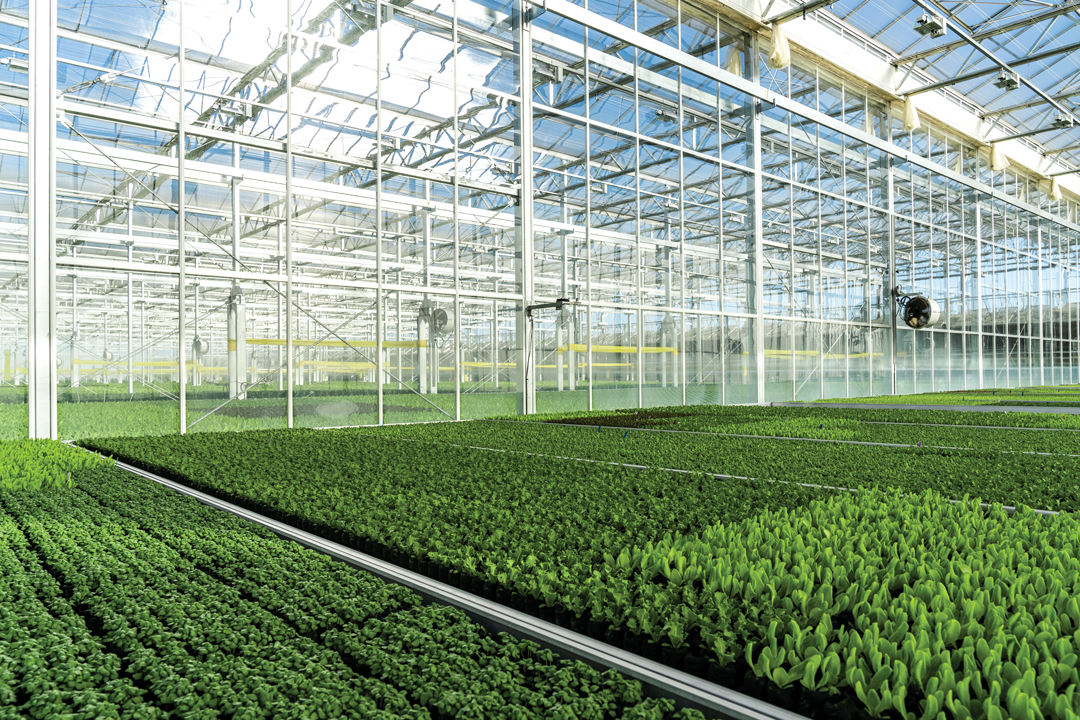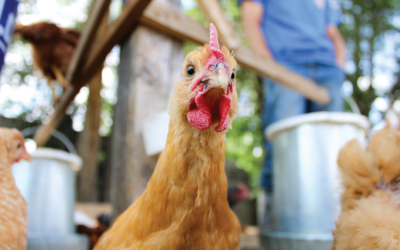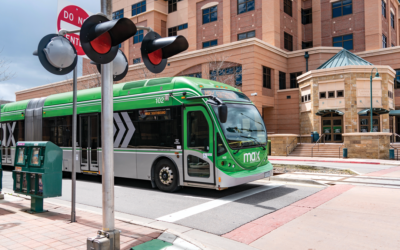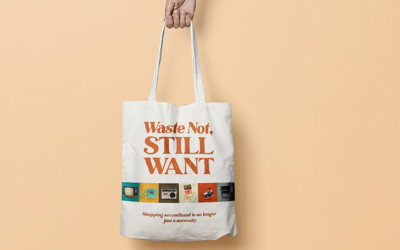At Gotham Greens’ Windsor facility, an enclosed farm under a glass roof spreads east and west as far as the eye can see. Over in the sterile food-grade packing section, employees don lab coats, hairnets and gloves to harvest and package the leafy greens. Both workspaces share a goal: to produce tasty lettuce year-round that gets to market a day after harvest.
A row of unfurled butterhead lettuce nestles against rows of Rocky Mountain Crunch (the crunchiest of the brand’s lettuce) and red oak leaf lettuce. Every variety is uniformly planted along metal gutters with multiple holes, each containing a peat pod with seeds.
The greenhouse uses automation and robotics for various tasks, including seeding and transplanting. No soil is needed; the plants are fed nutrient-rich water (a mix of nitrogen, phosphorus, potassium and other minerals) from emitters by gravity with one side of each gutter elevated several inches above the other.
The conveyor system shuffles the gutters from west to east in the greenhouse until the plants are harvested about a month later. Sensors measure humidity, light levels and water and air temperatures, and those numbers are fed into a computer that calculates growing algorithms.
A day’s work produces thousands of clamshell packages, which get shipped to stores like King Soopers, Whole Foods Market and Sprouts as well as other retail shops, food service companies and restaurants across the state.
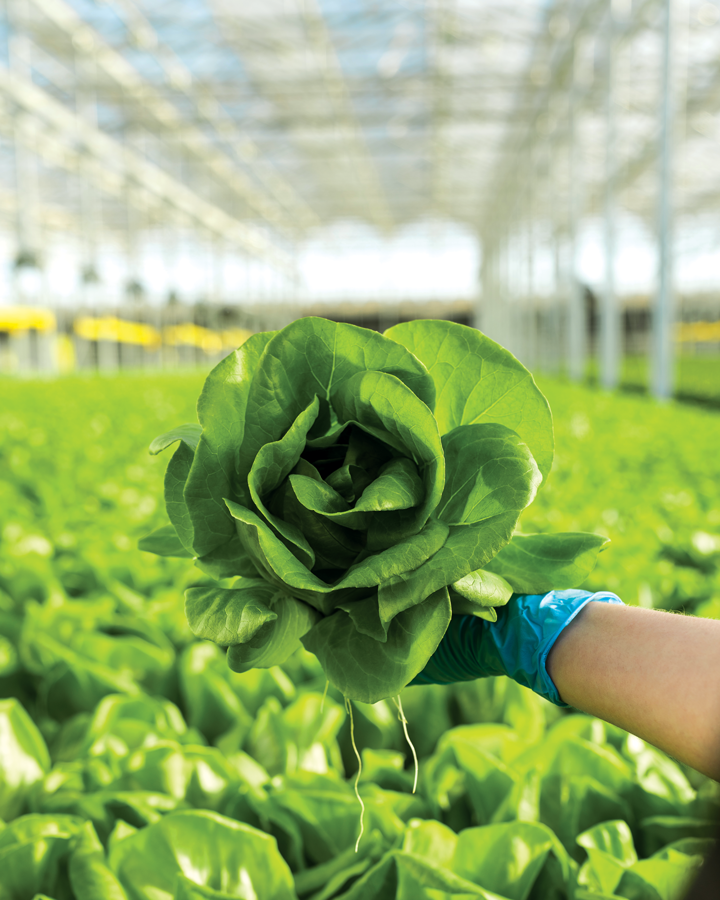
utterhead lettuce from Gotham Greens
History of hydroponics
It sounds like science fiction, but growers have practiced hydroponic methods since the Hanging Gardens of Babylon (where Iraq is located today) around 700 B.C. The Aztecs and Chinese also created floating gardens, and by the 1940s, the U.S. Army grew hydroponic vegetables on Iwo Jima and Okinawa to feed troops during World War II, according to High Times, a resource for marijuana growers, because yes, pot thrives hydroponically too.
“Enclosed growing became popular in the Netherlands over 60 years ago,” says Eric Haley, co-founder and chief financial officer at Gotham Greens. “Many European countries have a robust greenhouse economy. In some, up to 95 percent of their food is grown like that because of the cold climate, scarce land and to address food security concerns. Hydroponic history is a result of those countries trying to secure their food supply.”
While hydroponic concepts are old, the practice has developed slowly. In 2023, the U.S. hydroponics market was valued at $506 million, according to Grand View Research, or 10 percent of a $500 billion global market. They project a 10.7 percent compound annual growth rate in the U.S. from 2024 to 2030.
Growth factors for using alternative growing methods include climate change, reducing pesticide use and addressing food insecurity in population-dense urban communities where cultivable land is limited. Tomatoes, herbs, lettuce, peppers and cucumber plants do well with “smart farming methods,” according to the journal Bioinformation, because the technology uses less water, promotes environmentally safe ways to manage pests and allows for faster growing in ideal, year-round conditions.
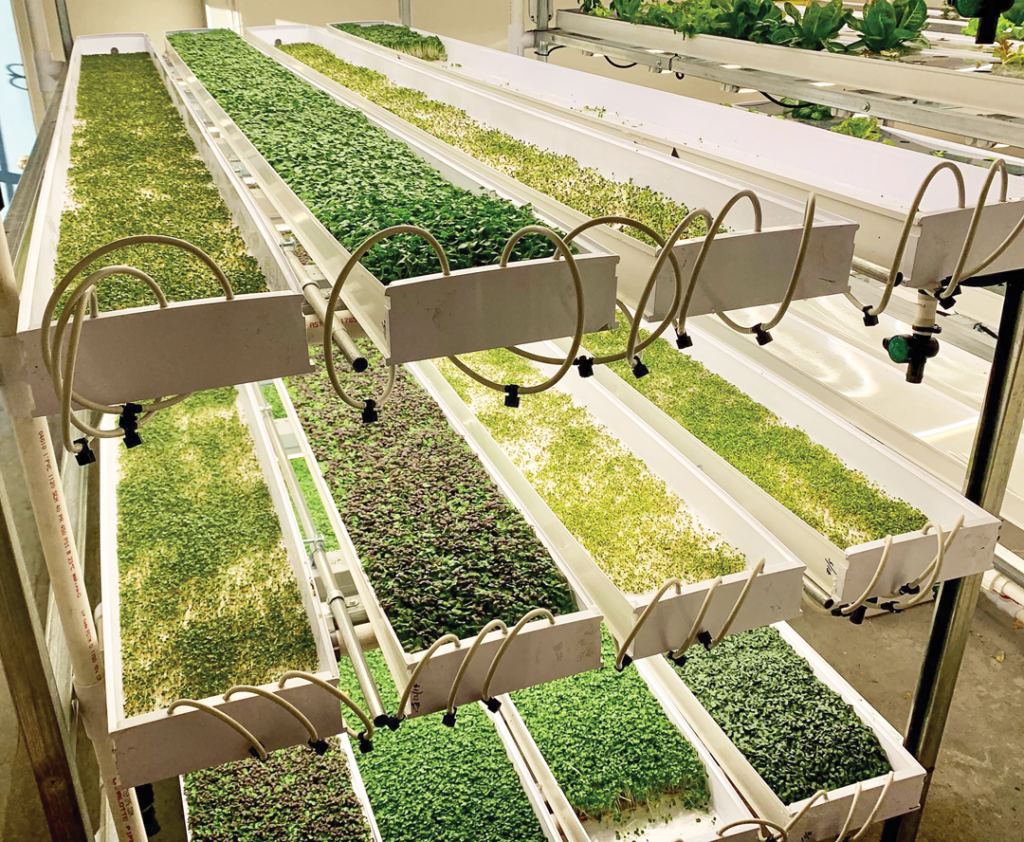
EP Greens, Estes Park
Sustainable expansion
For Gotham Greens, sustainability and locality drive their hydroponic growing methods. Haley and the other two founders—Viraj Puri, chief executive officer, and Jenn Frymark, chief greenhouse officer—began researching the U.S. lettuce supply chain in 2008 and learned that 99 percent of it came from Yuma, Ariz., and California’s Salinas Valley.
Conventionally grown crops are harvested in fields, often by migrant workers, and brought by refrigerated trucks to central processing facilities, where produce from dozens of farms is combined. After soaking the lettuce in water and chlorine baths to remove dirt (potentially introducing other pathogen risks), it is packaged under different brand names, distributed across the country and sold to consumers, Haley says.
The process takes multiple days, reducing shelf life for grocery stores and consumers.
Gotham Greens’ 13 greenhouses span the country, so their crops can reach local markets the day after harvesting. They started as a 15,000-square-foot unautomated rooftop farm above a warehouse and a second 20,000-square-foot rooftop farm above Whole Foods Market in New York City, where the founders helped 40 employees package and deliver the greens.
“Because of the proximity of our greenhouses to the market, the retailer gets many extra days of shelf life,” Haley says.
Hydroponic growing methods also save water. A one-acre hydroponic farm produces as much lettuce as a 30-acre outdoor farm and uses up to 90 percent less water, he says.
Since there is no soil involved and Gotham Greens’ products are free of pesticides and herbicides, there is no need to prewash their lettuce and herbs before eating them. Plants grown inside taste better too, and they take less time to grow.
“If you grow outside, the plant spends much of its energy dealing with the elements and getting roots through the soil to reach nutrients and water and has less energy to grow,” Haley says. “Indoors, the plant uses more energy to grow leaves, and the product is tenderer, flavorful and nutrient rich.”
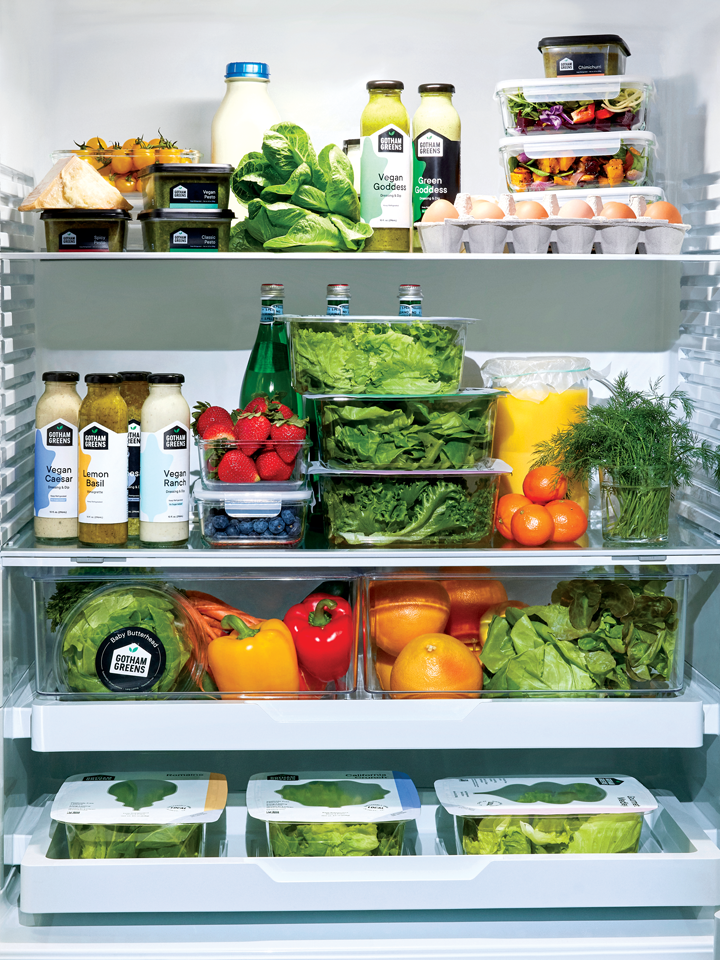
Gotham Greens offers a variety of products. Photo by Evan Robinson.
Size doesn’t matter
While Gotham Greens employs hundreds of people, many hydroponic growers are small family operations, like Forevergreen Farm, a subscription service that delivers organic microgreens to Northern Colorado homes and more than 50 local restaurants.
Another small-scale hydroponic grower, EP Greens, is run by Shane Bristow and his mother, Ellen, in Estes Park. They sell broccoli and mustard microgreens, lettuce, sunflower and pea shoots, herbs and wheatgrass. Their plants are grown in a rock wool substrate, Bristow says.
EP Greens’ farm consists of a 2,000-square-foot industrial space with 40-foot-tall ceilings, allowing about 8,000 feet of space for them to grow. They use 9-foot tables with 125-gallon reservoirs that are pumped with liquified minerals.
The Estes Park climate is amenable to the temperatures needed (about 65-70° F), enough that no air conditioning is required in the summer, Bristow says. Heating costs may increase when temperatures drop in the winter, but unlike Estes’ traditional four-month-long growing season, EP Greens is able to grow year-round. An exhaust fan sucks in cold air and evacuates it out the other side of the building, keeping the humidity level at a constant 50 percent.
“More humidity makes the environment hot, and it can get funky; the plants are more susceptible to powdery mildew and critters,” Bristow says. “We don’t grow stuff that attracts bugs—there are thousands of different lettuces you can grow that bugs don’t like.”
EP Greens has developed a loyal following at the summer Fort Collins, Estes Park and Longmont farmers markets, where they sell greens that are harvested on market day. In the winter, they supply the Fort Collins and Cheyenne farmers markets, and they sell their hydroponic produce two days a week onsite year-round.
“People love our lettuce,” Bristow says. “They swear it’s crispy, sweet and beautiful. The indoors thing allows you to grow prettier lettuce.”
Hydroponics at Home
Nearly anything can grow on your kitchen counter, says Ryan Null, regional manager and part owner of The Grow Shop in Loveland and Fort Collins. The business supplies commercial and home hydroponic growing systems built to customer specifications. The shop stocks seeds to grow herbs, vegetables, leafy greens and tomatoes, and it sells mushroom grow kits without spores (ordered separately).
“Most people start small—roughly one cubic foot works for a kitchen herb garden—but we can build a system that’s half a mile long if you like,” Null says. “Once you’re comfortable, you can add lettuce, peppers and tomatoes. The easiest to start with are microgreens and wheatgrass systems; you can harvest a tray after a week, and it costs $10 to get started.”
Natural lighting is ideal for growing herbs and microgreens. If your space doesn’t have a bright natural light source, The Grow Shop sells LED and compact fluorescent bulbs to use in existing sockets or reflector setups. The larger the system, the more expensive the lighting.
The final piece of the equation is the culture system, which depends on space and what you plan to grow. Narrow nutrient film technique trays irrigate using gravity, and deep water culture systems with connected buckets have constant water flow to prevent stagnation (good for tomatoes and long-rooted plants). Ebb-and-flow trays are good for microgreens, tomatoes and vegetables. Liquid nutrient systems add mixtures of nitrogen, phosphorus, potassium and other minerals to the water and are designed to build strong roots.


